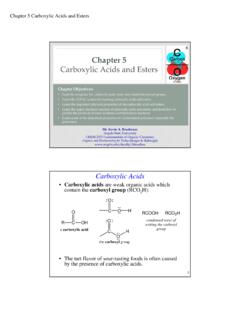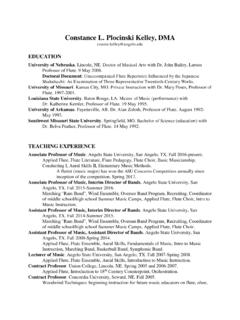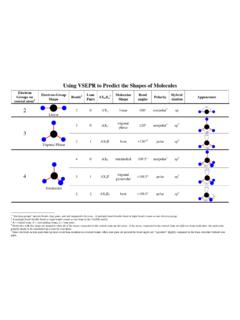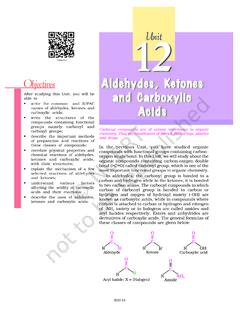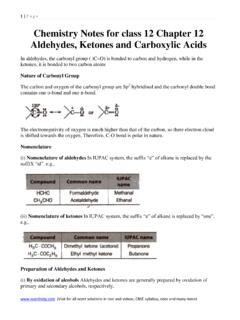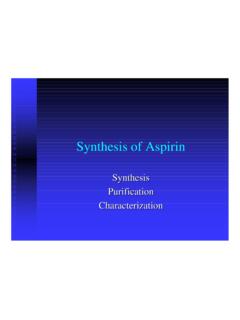Transcription of Ch 06 Amines and Amides - Angelo State University
1 Chapter 6 Amines and AmidesMr. Kevin A. BoudreauxAngelo State UniversityCHEM 2353 Fundamentals of Organic ChemistryOrganic and Biochemistry for Today (Seager & Slabaugh) Objectives: Learn to recognize the amine and amide functional groups. Learn the IUPAC system for naming Amines and Amides . Learn the important physical properties of the Amines and Amides . Learn the major chemical reactions of Amines and Amides , and learn how to predict the products of amide synthesis and hydrolysis reactions. Learn some of the important properties of condensation polymers, especially the 6 Amines and Amides2 Nitrogen-Containing Functional Groups Nitrogen is in Group V of the periodic table, and in most of its compounds, it has three single bonds and one lone pair: In this chapter, we will take a look at two functional groups which contain nitrogen atoms connected to carbons: the Amines and the "R'AmideNRR''R'AmineNChapter 6 Amines and Amides3 Classification and Nomenclature of Amines4 Amines Amines and Amides are abundant in nature.
2 They are a major component of proteins and enzymes, nucleic acids, alkaloid drugs, etc. (Alkaloids are N-containing, weakly basic organic compounds; thousands of these substances are known.) Aminesare organic derivatives of ammonia, NH3, in which one or more of the three H s is replaced by a carbon group. Amines are classified as primary(1 ), secondary (2 ), or tertiary(3 ), depending on how many carbon groups are connected to the nitrogen ''R'3 AmineNRHH1 AmineNRHR'2 AmineNHHHA mmoniaChapter 6 Amines and Amides5 Examples: Classifying Amines Classify the following Amines as primary (1 ), secondary (2 ), or tertiary (3 ).NCH3CH2CH2 HHNCH3CH3CH3CH3CH2 CHCH3NH2 NCH3CH2 HCH3 NHN6 Nomenclature of Amines Simple 1 , 2 , and 3 Amines : common (trivial) names are obtained by alphabetically arranging the names of the alkyl substituents on the nitrogen and adding the suffix -amine( , ethylmethylamine).
3 Amines in the IUPAC system: the e ending of the alkane name for the longest chain is replaced with amine. The amine group is located by the position number. Groups that are attached to the nitrogen atom are located using N as the position number. More complex primary Amines are named with NH2as the aminosubstituent. Aromatic Amines : named as derivatives of the parent compound aniline. Substituents attached to the nitrogen are indicated by using N- as the location 6 Amines and Amides7 Examples: Nomenclature of Amines Provide common names for the following 2 and 3 Amines ; for 1 Amines , provide common and/or IUPAC names where : Nomenclature of Amines Provide common names for the following 2 and 3 Amines ; for 1 Amines , provide common and/or IUPAC names where 6 Amines and Amides9 Examples: Nomenclature of Amines Provide common names for the following 2 and 3 Amines .
4 For 1 Amines , provide common and/or IUPAC names where : Nomenclature of Amines Provide names for the following aromatic CH3NH2CH3 Chapter 6 Amines and Amides11 Examples: Nomenclature of Amines Provide names for the following aromatic : Nomenclature of Amines Draw structural formulas for the following molecules: ethylisopropylamine tert-butylamine 2-pentanamineChapter 6 Amines and Amides13 Examples: Nomenclature of Amines Draw structural formulas for the following molecules: N-methyl-2-propanamine 1,6-diaminohexane 3-amino-1-propanol14 Examples: Nomenclature of Amines Draw structural formulas for the following molecules: N-methyl-2-chloroaniline N,3-diethylaniline N,N-dimethylanilineChapter 6 Amines and Amides15 Physical Properties of Amines16 Physical Properties of Amines : H-Bonding 1 and 2 Amines can hydrogen bond to each other:NCH3CH3 HCH3CH3 HNNCH3CH3 HNCH3CH3CH3CH3CH3CH3 NCH3 NCH3CH3XX 3 Amines cannot hydrogen bond to each other:NCH3 HHCH3 HHNNCH3 HHChapter 6 Amines and Amides17 Physical Properties of Amines : Boiling Points Nitrogen is less electronegative than oxygen, so the N H bond is not quite as polar as the O H bond.
5 Hydrogen bonds from N H s are not as strong as those resulting from O H s. Hydrogen bonding between 1 and 2 Amines is not as strong as those found in alcohols or carboxylic acids. 1 and 2 Amines have lower boiling points than alcohols of similar molecular weight. 3 Amines , since they do not hydrogen bond to each other, have boiling points similar to hydrocarbons of the same molecular Properties of Amines : Boiling PointsNameMolecular weightBoiling pointAcetic g/mol 118 g/mol 97 Cpropyl g/mol 48 Cethylmethylamine g/mol 36 g/mol g/mol CBoiling Point:Carboxylic acidAlcohols1 /2 Amines3 Amines /AlkanesChapter 6 Amines and Amides19 Physical Properties of Amines : Water Solubility 1 , 2 , and 3 Amines can all form hydrogen bonds with water.
6 Low-molecular weight Amines are generally Properties of Amines : Odor Low molecular-weight Amines tend to have sharp, penetrating odors similar to ammonia Higher molecular-weight Amines often smell like rotting fish, and are often found in decaying animal for the odor of rotting fishCH2CH2CH2CH2NH2NH21,4-Diaminobutane( Putrescine)A poisonous oil present in rotting flesh; produced during the decomposition of the amino acid arginine; alsopartially responsible for the odorof urine andbadbreathCH2CH2CH2CH2CH2NH2NH21,5-Dia minopentane(Cadaverine)A poisonous, viscous liquid present in rotting flesh; produced during the decomposition of the amino acid lysine; also partially responsible for the odor of urine andbad breathChapter 6 Amines and Amides21 Examples: Predicting Physical Properties Arrange the following compounds in order of increasing boiling point.
7 (All of the compounds have about the same molecular weight.)propanoic acid, diethylamine, 1-butanol, ethyldimethylamine22 Examples: Predicting Physical Properties Which member of each of the following pairs of compounds would you expect to have a higher boiling point? 2-aminopropane or2-aminohexane triethylamineor1-aminohexane propanoic acid ordiethylamine 1-pentanol or 1-aminopentaneChapter 6 Amines and Amides23 Some Important Alkaloids24 Important AlkaloidsNNNNOCH3 OCH3CH3 CaffeineFound in the seeds of Coffea arabica, roasted coffee beans; inhibits the action of phosphodiesterase, an enzyme which inhibits cyclic adenosine monophosphate (AMP), which is responsible for forming glucose in the bloodstreamNNNNOHOCH3CH3 TheobromineFound in the seeds of Theobroma cacao; the stimulating ingredient in tobacco plants; mild stimulant in small doses.
8 Addictive, but not especially harmful itselfNHONCH3 OQuinineAntimalarial drug from cinchona treeCH3 ONCH3 DextromethorphanIngredient in cough 6 Amines and Amides25 NCH3 OCH3 OOHHOC ocaineThe form which is snorted is the hydrochloride salt; the free-base crack form is burned and inhaled, and reaches the brain in 15 muscles and reduces secretionof saliva during surgery; used to dilate pupils for eye in treatment of motion sicknessNHHC oniinePoison fromhemlockZephiran chloride(benzalkonium chloride)Antiseptic compound that killsbacteria and fungi on contactN+RH3 CCH326 NOOHHHHHNS trychnineA poison from strychnos plant (Nux vomica); used as a rat and mouse poisonNNHOCH3 OHMelatoninA naturally occuring hormone produced in thepineal gland; its production is triggered by theabsence of light; causes drowsiness in humansat night, triggers birds to migrate, and signals dogs to shed their winter coats.
9 Sold as a treatment for jet acid diethylamide (LSD)A synthetic hallucinogen from alkaloids obtained from ergot, a fungus which grows on ryeInosine Monophosphate (IMP)With monosodium glutamate (MSG), one of the major substances responsible for the flavor of meatNNNNOHOOHOHPHOOHOC hapter 6 Amines and Amides27 OHOHONCH3 MorphineFound in the opium poppy; a CNS depressant; very effective painkillerOCH3 OHONCH3 CodeineUsed in some cough syrups to depress the action of the cough centerof thebrainOOONCH3CH3 OCH3 OHeroinMore fat-soluble than morphine, and must be injected directly into the bloodstream, but crosses the blood-brain barrier more readily, causing it to be more potent than morphine28 Nitrogen WastesThe disposal of waste nitrogen from the body is a problem which different species of animals have solved in different ways.
10 NH2 NONNOHHHOA llantoinMost mammals contain enzymeswhich metabolyze uric acid acidMarine vertebrates further metabolyze allantoin into allantoic acidBirds, reptiles and insects excrete nigrogen wastes in the form of uric acid. Uric acid can be eliminated directly in the solid form, withoutbeing dissolved in water. It is produced in the body from foods and beverages rich in purines, such as claret and port. Lactic acid inhibits the removal of salts of uric acid in the urine; these salts instead deposit in the joints, causing gout. Dalmations have been bred to have black spots with no white hairs in them on their coats; however, the gene which determines the presence of white hairs is linked to the gene which codes the enzyme which breaks down uric acid into allantoin.
